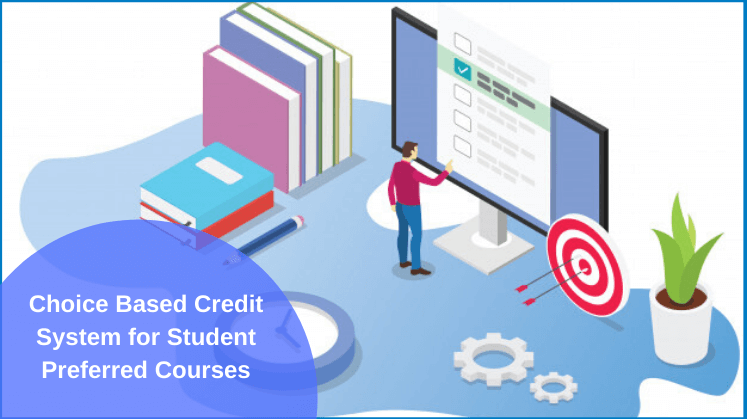04, Sep 2021
To maximize skill-based education & enhance student learning outcomes in terms of their grades as well as skills, the National Education Policy (NEP 2020) has made some crucial changes in the traditional teaching-learning system in India. The right to choose subjects & multidisciplinary education approach are the best takeaways. The government has decided to introduce a unique concept of Academic Bank of Credit (ABC) coupled with CBCS to facilitate the best education journey to the career-oriented students of the 21st century.
What is CBCS?
Popularly known as CBCS, full form- ‘Choice Based Credit System’, provides a convenient at the same time effective teaching-learning platform wherein the student or knowledge seeker has the flexibility to choose their course from a list of elective, core, and soft skill courses.
The CBCS (Choice Based Credit System) provides an option for the students to select courses from the prescribed courses comprising core, elective, minor or skill based courses. The courses are often evaluated following the grading system, which is considered to be better than the traditional marks system.
In simple words, I’d define it as a student-centric approach to learning or acquiring higher education. The conventional system of Higher Education didn’t give much scope to students. The course and learning content were predefined, redundant, and not up-to-date. For students to apply their knowledge base later in their work environment, business, or life; the conventional isolated courses lacked contemporary appropriateness.
What is Choice Based Credit System’s Differentiator?
The CBCS system or Choice Based Credit System follows semester-wise pattern - even & odd semester that sums up to an academic year. Instead of percentage-wise grading, the CBCS uses a grading and evaluation system to map student performance. It follows a credit system that is attached to the course components offered to students. The not only opens pathways for learning opportunities but also manifests learning goals and objectives.A credit system for higher education measures various parameters like-
- Student performance
- Learning outcomes
- Entrepreneurship skills
- Contact hours
- Innovation
- Creativity & talent
The CBCS system is an initiative of the University Grants Commission (UGC); which enhances and promotes the educational liberalization of existing conventional higher education models.
Top Advantages of the Choice Based Credit System (CBCS)
- The student has an option to choose inter/multidisciplinary courses
- Based on the IQ level of an individual student; a mentor guides students to select courses
- It promotes group work, research, and community involvement
- It gives prospects to the learner to earn certification through a walk-in/walk-out approach
- Provides students with greater flexibility in the choice of courses
- Students can choose courses at a basic or advanced level
- Learners acquire job-oriented skills
- Student progress at their own tempo
- Highly motivated students get the chance to gain extra credits
The CBCS system not only bridges the gap between professional and social exposure but provides holistic education.
What Benefits Does CBCS Have To Offer The Faculty Members?
Key Features of the CBCS System
- Credits can be transferred if the student changes his/her branch of study
- CBCS is a step towards moving away from numerical marking to grading
- Grading minimizes the stigma of "fail"
- The credit based grading system is considered desirable because it facilitates student mobility across institutions within the country and across the globe
- Potential employers can assess the students performance, judicially
The Meaning of Choice Based Credit System (CBCS) in Brief
- CHOICE BASED - Choice of multiple courses
- GRADING - Marks secured is in letter grade format
- SEMESTER - Learner-teacher engagement quotient can be measured/ identified semester-wise
- CREDIT - Class hours per week carries additional importance in credit system
- ASSESSMENT - In the form of class room attendance, Mid Term Tests etc; is continuous and wide-ranging.
UGC has introduced a 10-point CBCS grading system as follows:
| O (Outstanding) | 10 |
| A+ (Excellent) | 9 |
| A (Very Good) | 8 |
| B+ (Good) | 7 |
| B (Above Average) | 6 |
| C (Average) | 5 |
| P (Pass) | 4 |
| F (Fail) | 0 |
| Ab (Absent) | 0 |
Credits are calculated keeping in mind the following components:
- Lecture (L)
- Tutorial (T)
- Practical (P)
The course may have all components of evaluation or a combination of any two; listed above. Although the CBCS system is tried and tested, it sometimes lacks an accurate estimation of marks. Teachers are further challenged to keep pace with many courses. This system furthers confusion among students; as each student has a different timetable and course of study. Nonetheless, the CBCS system is flexible and student-centric, this approach matches today’s demands of the student/learner community.
This CBCS system works in compliance with other grading systems of institutes, globally.
How CBCS System Works?
The choice-based credit system is an educational approach in which the students choose subjects from the prescribed courses. They are referred to as core, elective, major, or minor courses and the students can complete them at their own pace. The assessment of these courses is based on a credit system. It allows students to choose courses from any college or university in any part of the world.
1. Semesters
Student assessment is conducted semester-wise based on the course taken by them. They move ahead at their own pace rather than completing the course in the time duration given by the university. The semester contains academic work of around 15 to 18 weeks which contributes to the 90 teaching days.
2. Credit System
Every course contains a certain number of credits. The students earn the credits after passing the course assessment. After the students clear a course in one semester, they do not have to repeat the course in the next semester. Also, the students can complete the course at their pace.
3. Credit Transfer
The credits can be transferred to the next semester or the one after that if the student fails to complete the course. They have the freedom to study courses and earn fewer credits in case of any disease or injury and can compensate for the course in the coming semesters.
4. Comprehensive Continuous Assessment
The students are constantly evaluated for their progress by the teachers as well as by the students themselves.
5. Grading:
The University Grant Commission has given a 10-point grading system to assess the student’s performance in courses:
- O (Outstanding): 10
- A+ (Excellent): 9
- A (Very Good): 8
- B+ (Good): 7
- B (Above Average): 6
- C (Average): 5
- P (Pass): 4
- F (Fail): 0
- Ab (Absent): 0
Implement the Most Trustworthy CBCS System by MasterSoft
MasterSoft has designed CBCS software, which manages the CBCS system for educational campuses. The educational ERP software eases the manual task of administration and faculty. The educational ERP helps in data collection, student participation, course creation, etc.
Choice Based Credit System By MasterSoft
Functionality & Features of Our Solution for CBCS System are Highlighted Below
- A sleek and minimalistic dashboard which displays the university user login, a brief about the institute, news, and notices
- The University can have multiple users. The user can view his/her profile as well as change password
- Three main dropdown options namely; Administration, Academics, and Examination which facilitate easy management of the entire CBCS System
- The student has the mobility to register, apply, keep track of courses selected and examination schedule through our Solution
- Faculty has the flexibility to manage student data, create courses and schemes, offer courses, allot curriculum and assign/ transfer teachers
- Through this solution, the teacher can prepare teaching plans, mark attendance and prepare assignments for students
- Not only does this software facilitate defining the rules for CBCS system but also filters students for courses
- University can define requisites and allot mentors to students (mentors help the student in the selection of courses based on their IQ level and scope of the study) through our solution
- Lastly, reports can be generated for each of the services that are listed above
- Solution for CBCS system is holistic, easy-to-use and provides comprehensive management
How MasterSoft's CBCS System Can Help Institutions?
The implementation of the CBCS system can prove beneficial for Institutes. The student-centric approach of education creates interest and applicability in the scope of the study. Our solution enables easy management of Choice Based Credit System in Educational Campuses.
MasterSoft offers customized ERP solutions keeping in mind the growing need to automate credit courses of higher education. The campus management ERP software systems are specially designed and developed to simplify the administrative work of an institution. We believe that solutions that are provided to our educational campuses’ clients should be integrated with the best ERP features; we provide better adaptability by minimizing manual work; thus promoting structured output data for maintaining records, plus retrieve statistics. ERP integration helps in generating a countless number of 100% accurate & insightful reports, be it for school, faculty, administration, or student.
Explore the prime advantages that the CBCS system has to offer to the faculty & teaching staff here - Choice Based Credit System in Higher Education | Advantages of CBCS System for Faculty
No academic freedom?
Let your students choose subjects of their interest & follow their passion with MasterSoft's CBCS System!
Mobile: 08448010216
Email:info@mastersofterp.com
FAQs On Choice Based Education System (CBCS)
The Choice Based Credit System (CBCS) is an educational approach that enables the students to learn courses & subjects of their choice at their own pace. They are referred to as the core, elective courses, open or global electives & skill-based courses. It works on a credit-based system for student evaluation.
CBCS evaluates students based on credits rather than marks or grades. The students are evaluated based on their performance in the test for the course selected by them. They are allowed to choose courses from any institute across the globe.













